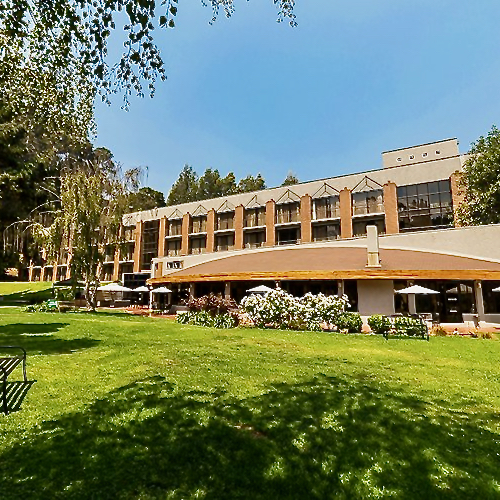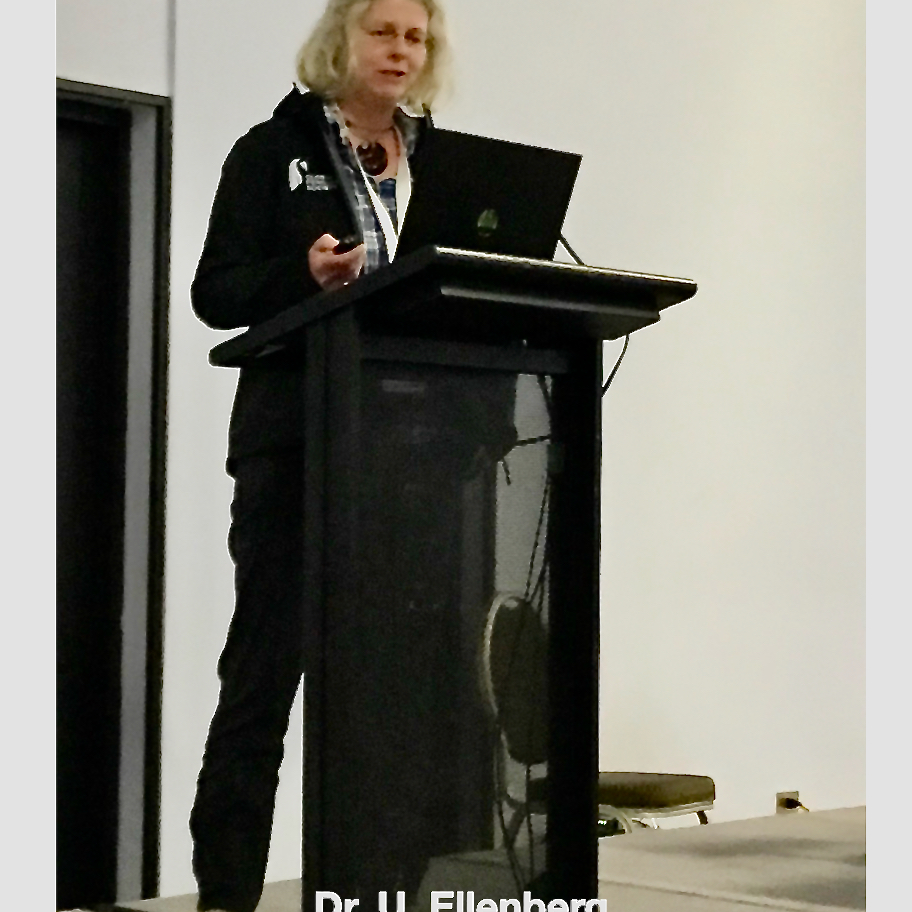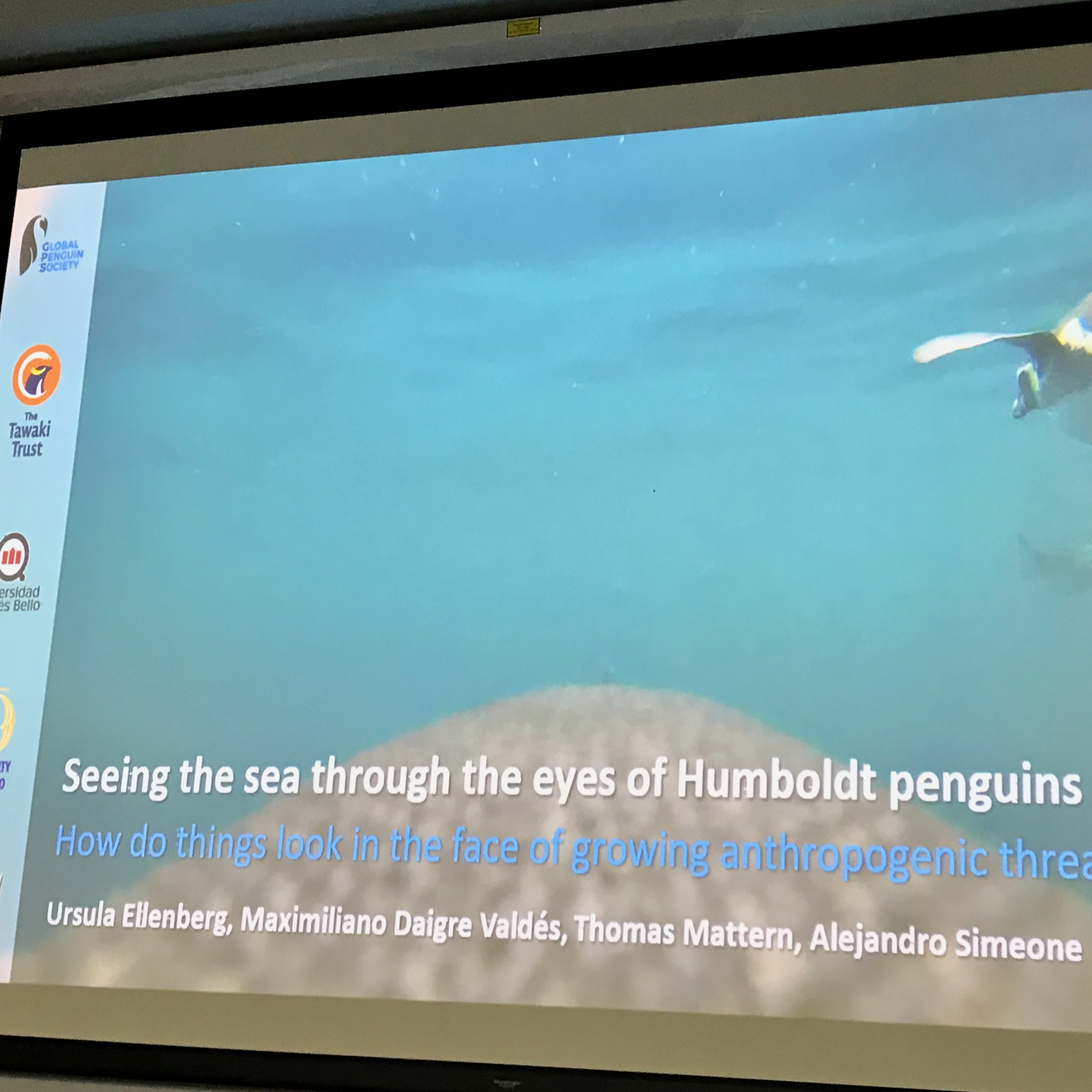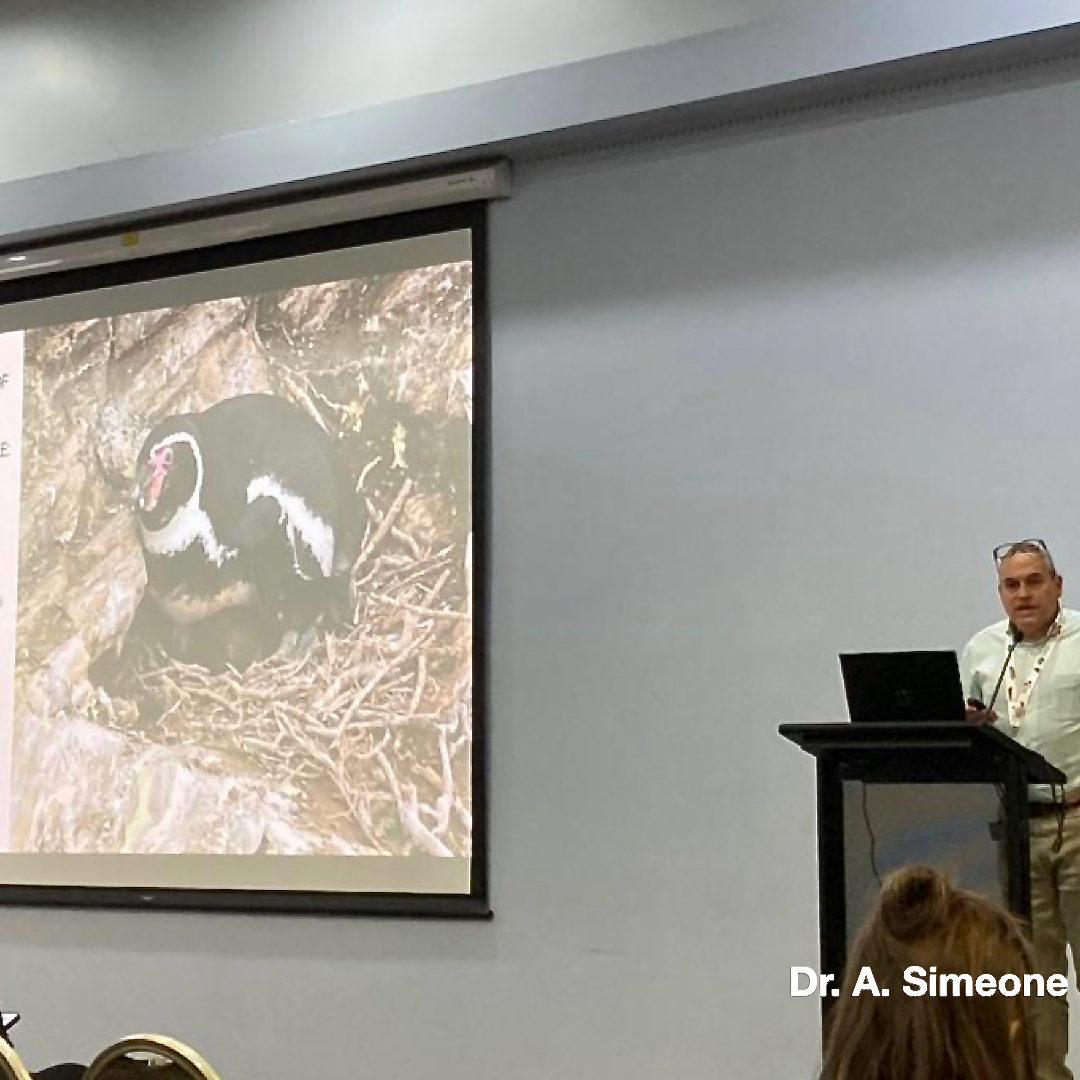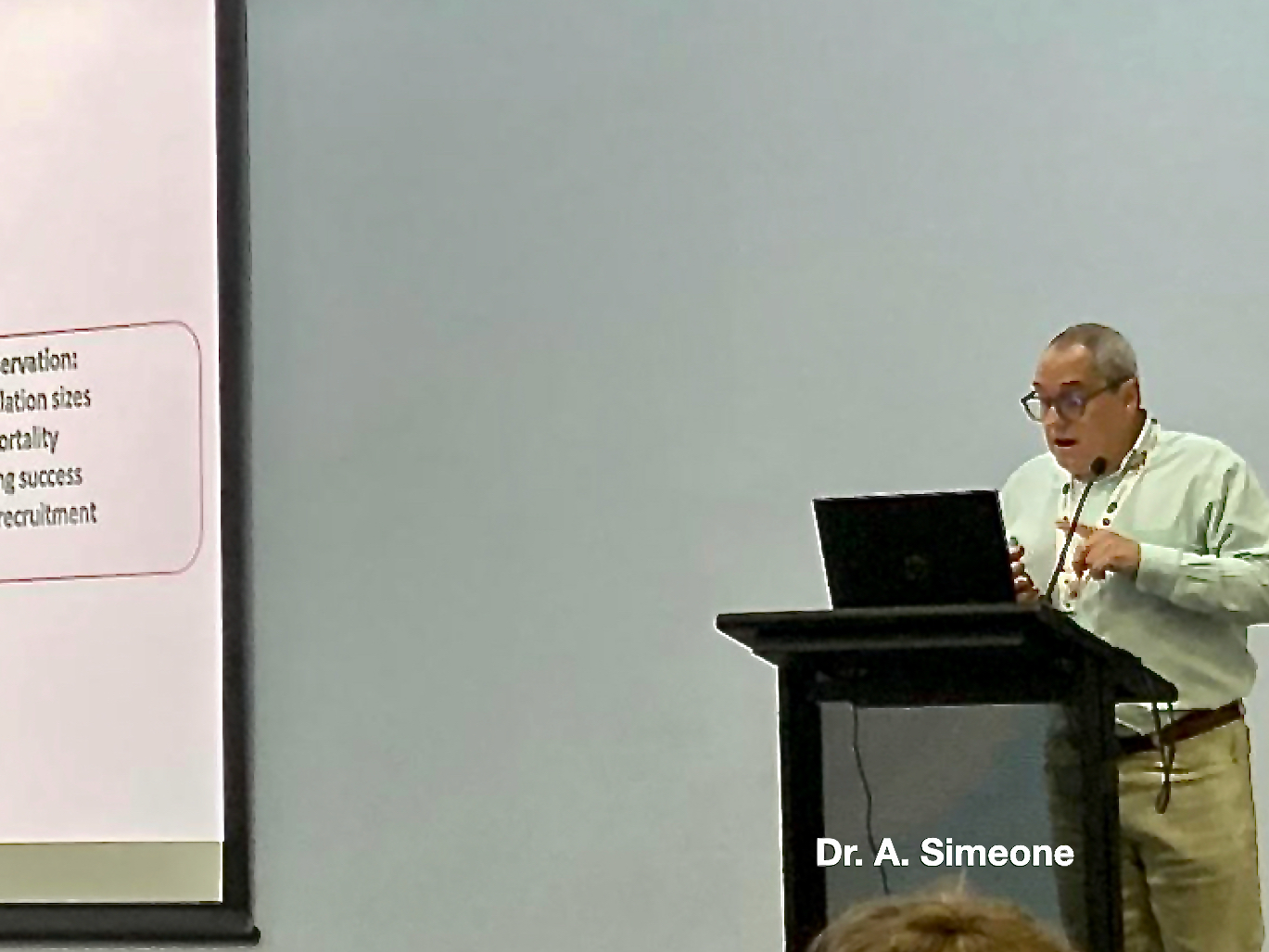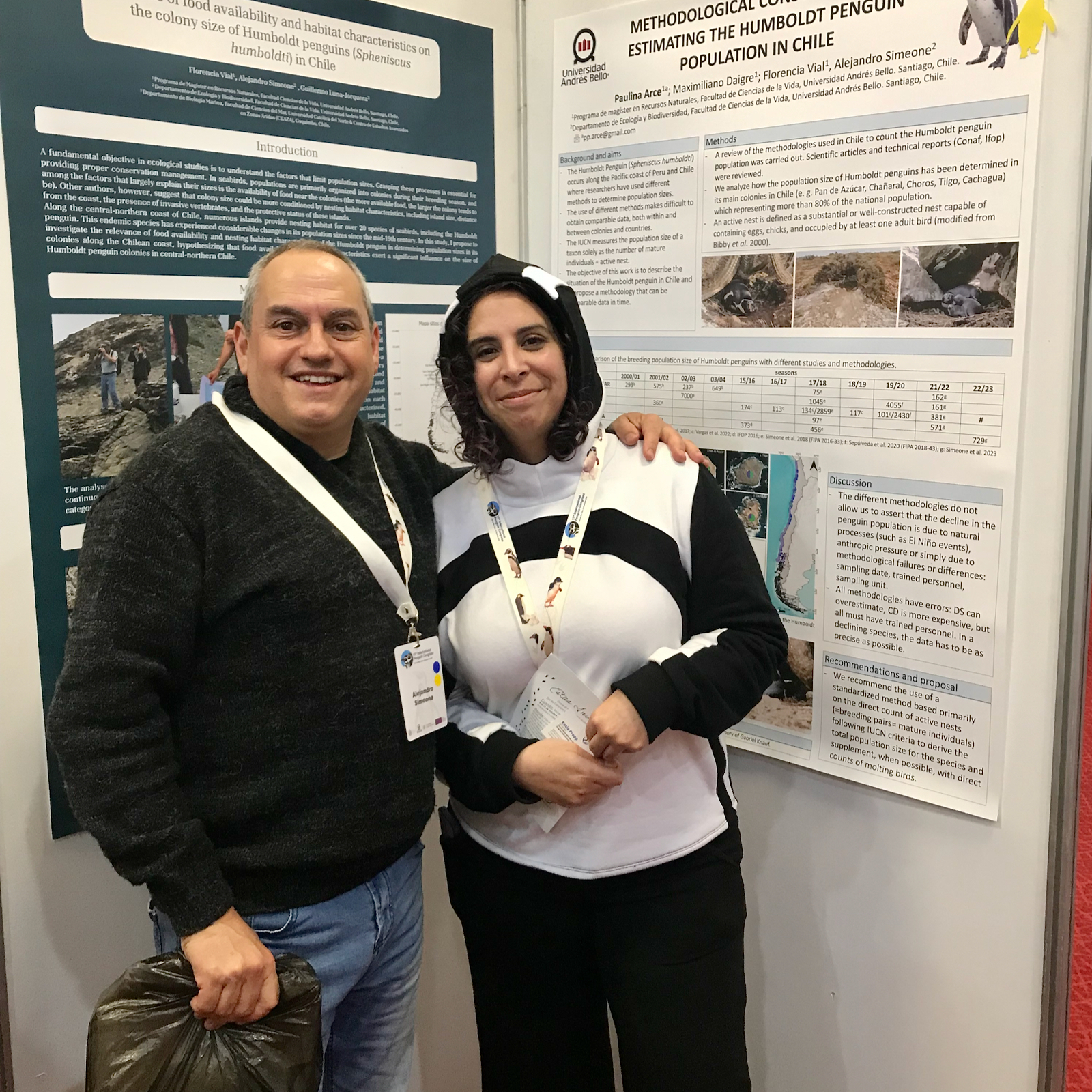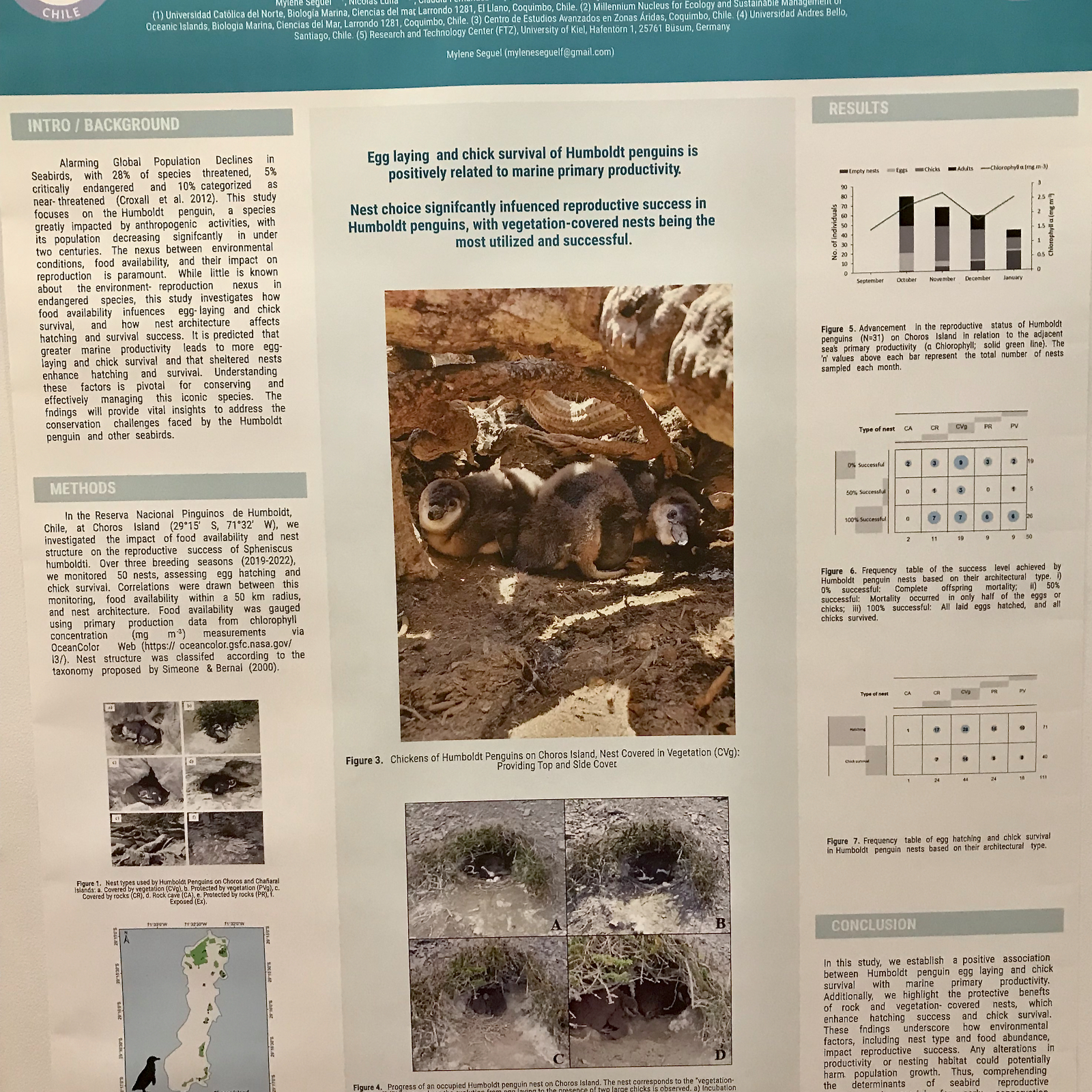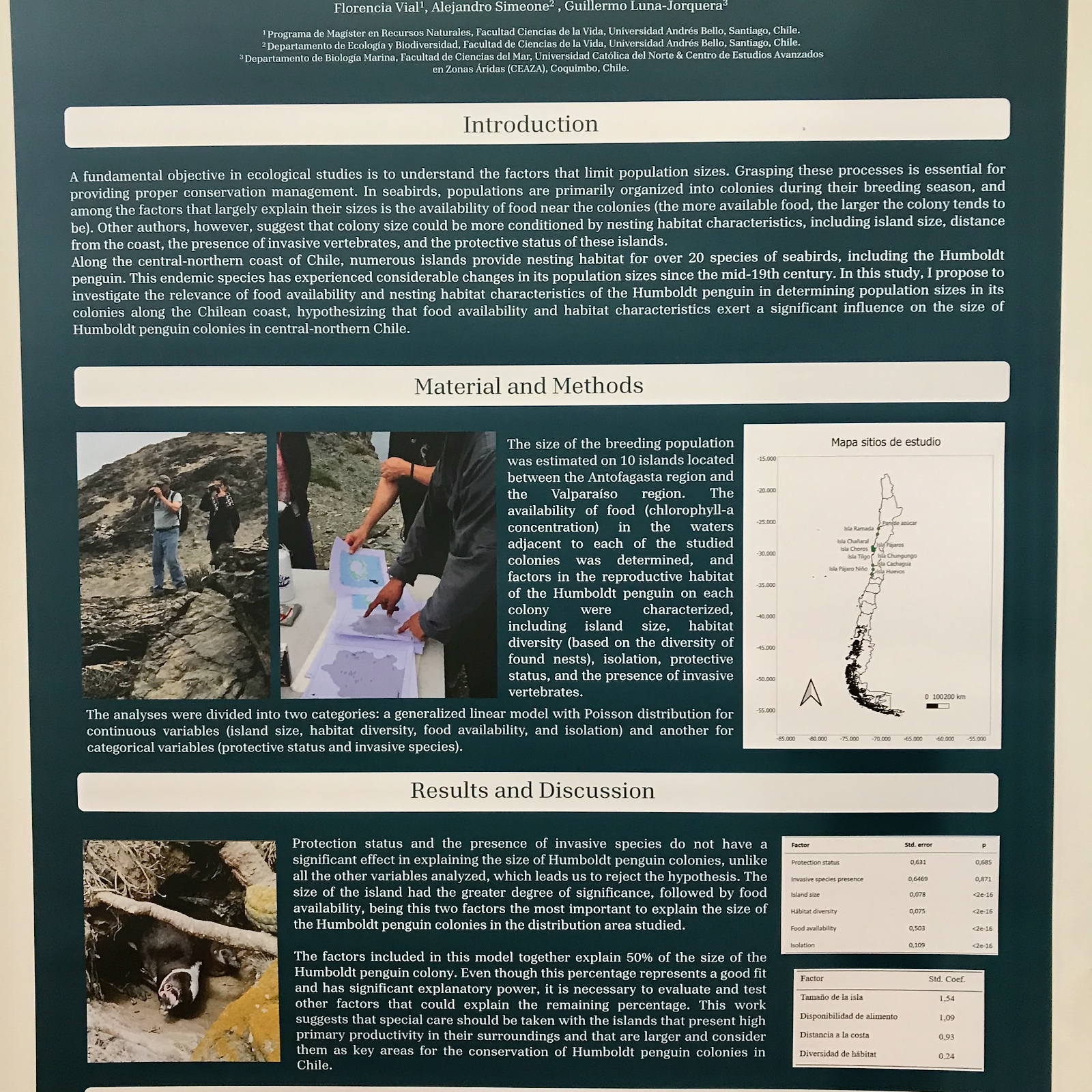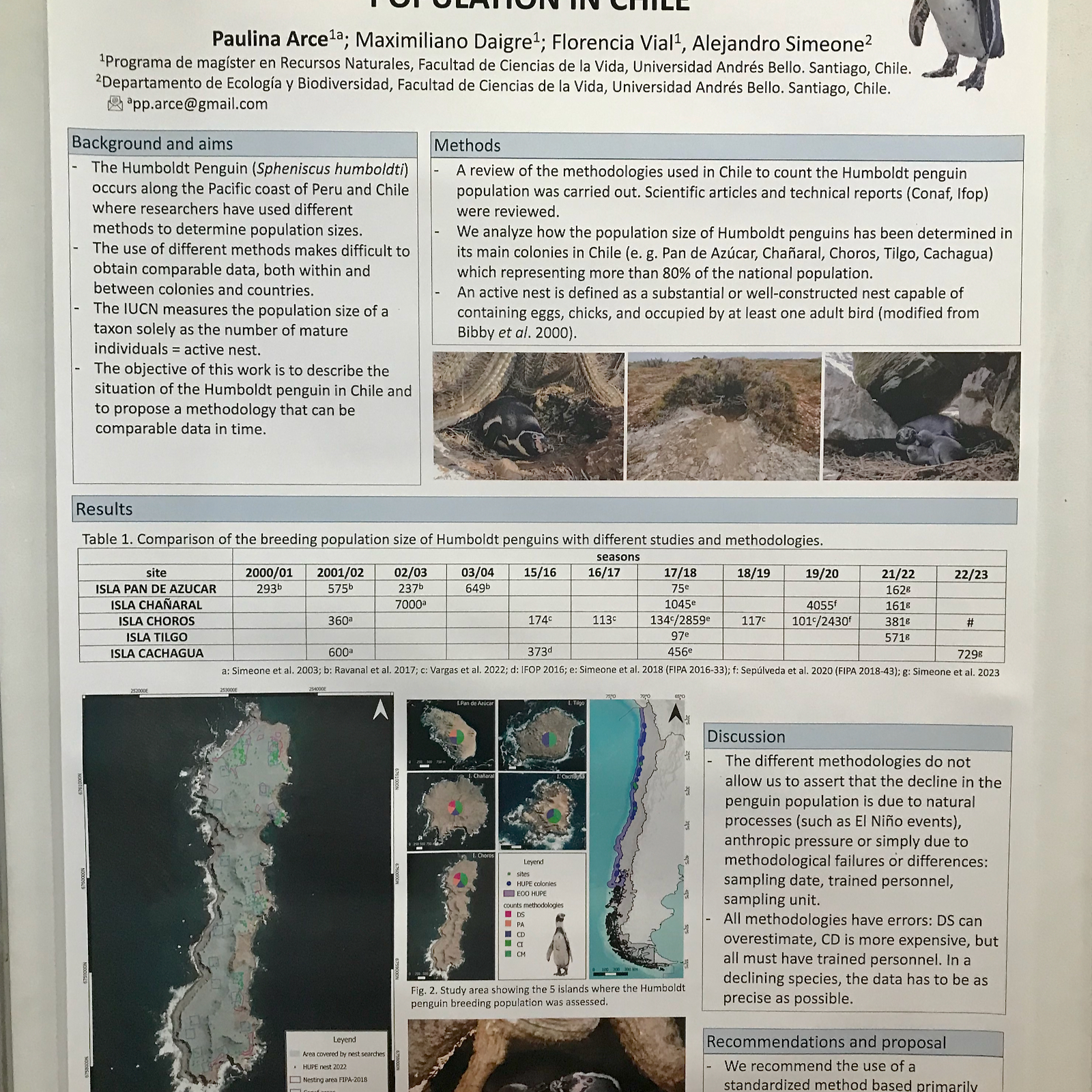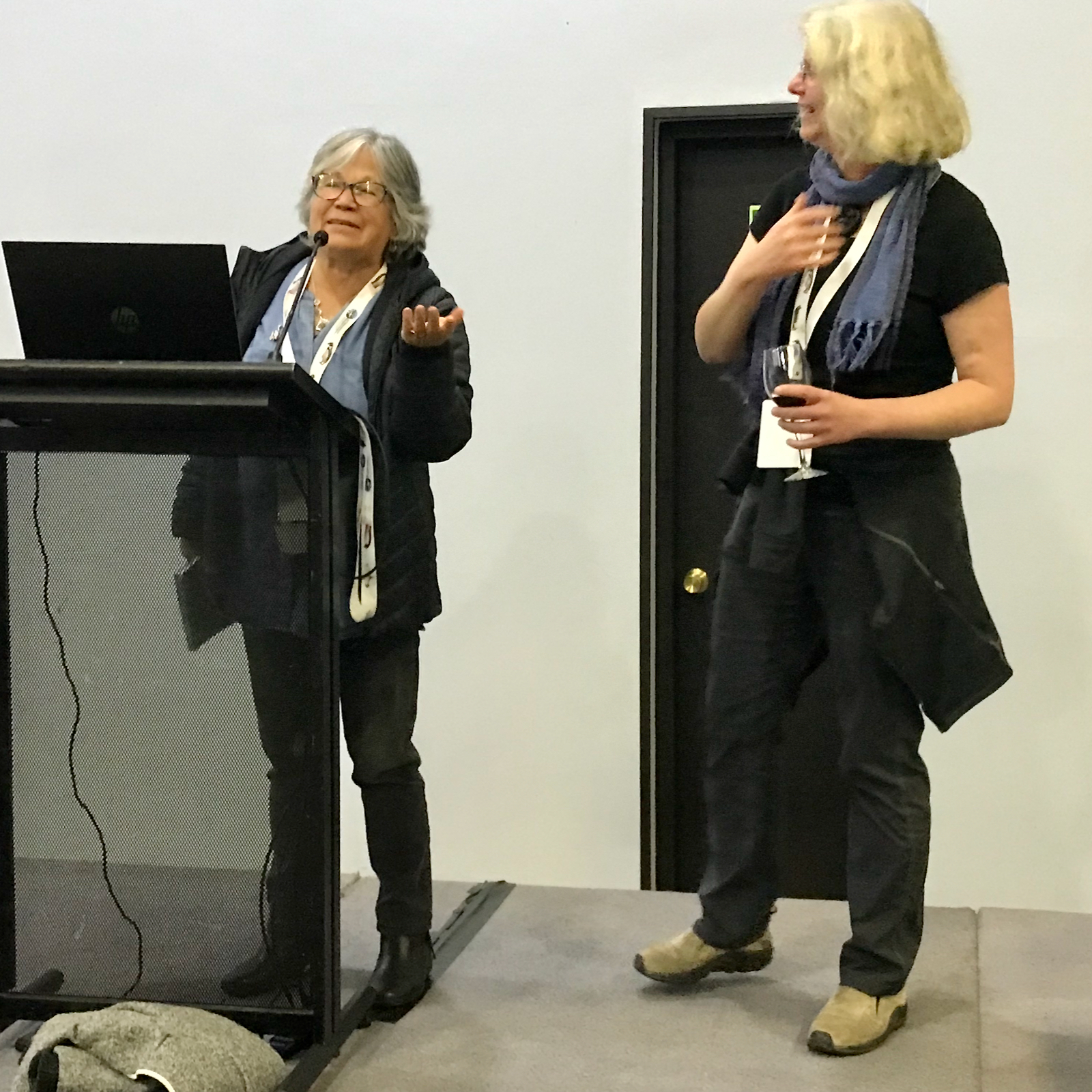Viña del Mar, Landau, September 17, 2023 – From September 4th to 9th, experts from all over the world met in Viña del Mar, Chile for the 11th International Penguin Congress. More than 200 scientists and experts in the conservation of various penguin species presented and discussed new research results in 75 lectures and 86 poster presentations. Alejandro Simeone (Universidad Andrés Bello), Juliana Vianna (Pontificia Universidad Católica de Chile) and Guillermo Luna-Jorquera (Universidad Católica del Norte) were responsible for the local organization.
Three lectures and three poster presentations informed about the results of research and educational projects that were and are supported by Sphenisco. The studies in Chile on population, breeding success and foraging, which are eminently important for species conservation (lectures 30 and 47, and posters 6, 66, and 67), were funded by the Karlsruhe Zoo Species Protection Foundation, Dresden Zoo and the Friends of Hagenbeck Zoo.
Lecture 30
Seeing the sea through the eyes of the Humboldt penguins - what does it look like in the face of the growing anthropogenic threat?
Under this title, Ursula Ellenberg presented completely new findings on the foraging of Humboldt penguins, which were obtained in 2022 near the island of Choros, northern Chile.
Some of the penguins went in search of food in the immediate vicinity, but most of them up to 10 km downstream from Choros. They would thus be affected by possible pollution from the planned ports and shipping lanes. With the help of penguin cameras, it was shown that the Humboldt penguins routinely searched for small fish hidden in the tentacles of jellyfish. With this insight, the speaker linked the hope that this behavior could be a promising strategy in view of climate change and ocean acidification. Individual animals hunted pelagically (facing the open sea) near the surface for individual fish, young schooling fish and squid. However, the penguins also went in search of food in groups of sometimes more than 50 individuals to catch fish at the bottom of the sea. This behavior means an increased risk of mortality as bycatch, as a single net can kill an entire group of birds hunting together. According to Ursula Ellenberg, the surprisingly flexible catching strategies of Humboldt penguins could be an opportunity to adapt to global change if other anthropogenic threats can be reduced. This research is particularly important as it provides reliable data for marine spatial planning and thus the possibility of reducing anthropogenic impacts on this endangered species. (see also "Projects Chile" of 9 July 2023, 1 January 2023 on this website).
Lecture 45
Protection of the Humboldt penguin in Ica, southern Peru
Señora Milagros gave her lecture in Spanish. Dr. Alejandro Simeone translated it into English. The speaker recalled that since 2010, Acorema has been working to raise awareness of the protection of Humboldt penguins in important groups such as students and teachers, fishing cooperatives, local guides and tour operators, youth groups and universities. In the meantime, an estimated 55,000 people and 98 institutions have been reached. (see also "Projects Peru" of 31 May 2023; 27 February 2022; 8 May, 16 February and 4 January 2021; and 11 June 2020 on this website).
According to Dr. Simeone, the description of the lively work with children, which was illustrated with many pictures, met with a great response, created a good atmosphere and became a highlight of the congress. This is also echoed in the words of Señora Milagros when she wrote to Sphenisco: "I am very happy that we were able to present the work done with Sphenisco and it seems that many of those present were impressed by the activities with the children, the materials created, the work with the authorities, etc. I have received many congratulations for what I have shown, and I pass it on to the Sphenisco team, which has been and continues to be a very important pillar over the years."
Lecture 47
Protection of the Humboldt penguin in Chile: Are we doing enough?
Dr. Simeone began his lecture by stating that exploitation of guano deposits, El Niño events and excessive fishing are the main causes of the decline of Humboldt penguins from hundreds of thousands in 1850 to no more than 3,000 breeding pairs in Chile. In order to conserve the species, Chile has over the past 40 years:
1) created national parks/reserves to protect the main islands where Humboldt penguins breed,
2) designated marine protected areas around the islands where penguins breed,
3) classified the Humboldt penguin as endangered, and
4.) developed a national management plan.
This management plan was finally adopted by the Chilean government shortly after the penguin congress, on September 13th - after 8 years in the drawer.
In Viña del Mar, Dr. Simeone raised the question "whether the measures mentioned are sufficient to adequately protect the Humboldt penguin?" He pointed to a recent census (2021-2022) that found that the breeding population in Chile is likely to be no more than 3,000 pairs and that large colonies have become smaller over the past two decades. Although broods are reported from 32 islands, there are fewer than 50 pairs living there each. 90% of the breeding population lives on six islands. As early as 2019, the assessment of the viability of populations and habitats suggested that the total population could decline by an average of 7% per year, predicting a period of 59 years to extinction. Dr. Simeone judged the management decisions to be correct, but not sufficiently effective and concluded: "We may not be doing enough to adequately protect the Humboldt penguin." (see also "Projects Chile" of 9 July 2023, and 1 January 2023 on this website).
He dedicated his presentation in loving memory to Gabriele Knauf, the late chairwoman of Sphenisco.
Poster 6
Investigation of the influence of food availability and nest structure on the reproductive success of Spheniscus humboldti on the island of Choros, Reserva Nacional Pinguinos de Humboldt
This study on the island of Choros investigated how food availability and nest structure influence the reproductive success of Humboldt penguins. 50 nests were monitored in 3 breeding seasons (2019 to 2022). The hatching and survival of the chicks was checked. Monitoring was then linked to food availability within a 50 km radius, as well as nest architecture. The speaker Mylene Seguel presented the following results:
1. A hatching rate of 82.6% was found in a total of 86 eggs, but only 56.3% of the 71 chicks survived.
2. Most of the egg-laying occurred one month after the peak of marine productivity.
3. Most of the hatched chicks and surviving chicks were in nests completely covered by vegetation. Food availability and nest structure can therefore have a significant influence on the reproductive success of penguins. This shows that in the management of marine regions, well-founded decisions regarding the conservation of Humboldt penguins depend on an understanding of their reproductive ecology and their relationships with the environment. (see also "Project Chile" of 9 July 2023, and 1 January 2023 on this website).
Poster 66
Oceanographic and habitat features influencing the colony size of Humboldt penguins (Spheniscus humboldti) in Chile
Florencia Vial began her presentation by stating that identifying the factors that determine the size of breeding colonies in seabird populations is crucial for understanding ecology and developing conservation strategies. The subject of the presented study was to investigate how the island area, habitat diversity, distance to the mainland, latitude, the presence of invasive species, the protection status of the islands and food availability affect the population size of ten Humboldt penguin colonies in north-central Chile during the breeding seasons 2021 and 2022.
As preliminary results, the speaker states that the protected status (e.g. national park, nature reserve) and latitude have no significant impact on colony size. However, the presence of invasive vertebrate species, including rats and European rabbits, are the main factors affecting the size of the colonies, i.e. when these two invasive species are present on the islands, the number of penguin pairs decreases significantly. The significance of these preliminary results for the development of sound management plans for the Humboldt penguin was discussed.
Señora Vial also dedicates the presentation of her research group in loving memor to Gabriele Knauf. (see also "Projects Chile" of July 9, 2023, January 1, 2023 on these pages).
Poster 67
Methodological limitations in estimating the Humboldt penguin population in ChilePaulina Arce explained that in the current situation where biodiversity is declining, it is crucial to provide reliable information on population sizes and trends of endangered species in order to allow, among other things, their classification in Red List categories.
This requires accurate, tailor-made and standardized methods to obtain and compare data. Researchers have used various methods to determine the population size of Humboldt penguins in the past, including direct counting of moulting birds and active nests, as well as indirect estimates through statistical methods (e.g., distance samples, monitoring squares). The use of different methods makes it difficult to compare the collected data both within colonies and between colonies and countries. Paulina Arce and others analyzed how the population size of Humboldt penguins was determined in the main Chilean colonies (e.g., Pan de Azúcar, Chañaral, Choros, Tilgo, Cachagua) and how the different methods led to contrasting results. They found that the number of breeding pairs is six to eight times higher with statistical methods than with conventional direct counting of active nests. This makes it difficult to make comparisons and create appropriate management strategies for this species. In order to determine the total population size of the species, the research group recommends the use of a standardized method based primarily on the direct counting of active nests according to the criteria of the IUCN. (see also "Projects Chile" of 9 July 2023, and 1 January 2023 on this website).
Paulina Arce also dedicates the presentation to Gabriele Knauf in loving memory.
In a discussion after the congress, Dr. Simeone, one of the organizers, was very satisfied, but also thoughtful: "The level and quality of the research results presented were very good. While research is developing extremely positively in terms of methodology and technology and is producing more and more well-founded results, the populations of many penguin species are declining at the same time."
W.K.
translated by Erich Greiner
Note:
The following researchers were involved in the six lectures.
(30) The sea with the eyes ...
Ursula Ellenberg (1-3), Maximiliano Daigre (4), Thomas Mattern (2,3,5), Alejandro Simeone (4)
(1) Department of Marine Science, University of Otago, Dunedin, New Zealand
(2) Global Penguin Society, Puerto Madryn, Argentina
(3) The Tawaki Trust, Dunedin, New Zealand
(4) Department of Ecology and Biodiversity, Universidad Andrés Bello, Santiago, Chile
(45) Protection of the Humboldt pinguins in Ica, Südperu
Ormeño Benavides (1), Helbert Alejandro Anchante Herrera (2), Julio César Reyes Robles (1), Mónica Aud Echegaray Skontorp (1), Jesús Roberto Ormeño Benavides (1)
(1) Coastal Areas and Marine Resources, Pisco, Peru
(2) National Forest and Wildlife Service, Directorate of Studies and Research, Lima, Peru
(47) Protection ... in Chile: Are we doing enough?
Alejandro Simeone (1)
(1) Department of Ecology and Biodiversity, Faculty of Life Sciences, Universidad Andrés Bello, Chile
(6) Study on the influence of food availabilty and…
Mylene Seguel (1), Nicolas Luna (1), Claudia Fernandez (1), Alejandro Simeone (4), Guillermo Luna-Jorquera (1,2,3)
(1) Universidad Católica del Norte, Marine Biology, Marine Sciences, Larrondo 1281, El Llano, Coquimbo, Chile.
(2) Millennium Nucleus for Ecology and Sustainable Management of Oceanic Islands, Biologia Marina, Ciencias del Mar, Larrondo 1281, Coquimbo, Chile.
(3) Center for Advanced Studies in Arid Zones, Coquimbo, Chile.
(4) Universidad Andres Bello, Santiago, Chile.
(66) Oceanographic and habitat features that ...
Florencia Vial (1), Guillermo Luna (3), Alejandro Simeone (2)
(1) Universidad Andrés Bello, Master's Program in Natural Resources, Faculty of Life Sciences, Republica 440, Santiago, Chile.
(2) Universidad Andrés Bello, Departamento de Ecología y Biodiversidad, Facultad de Ciencias de la Vida, republica 440, Santiago, Chile.
(3) Universidad Católica del Norte, Department of Marine Biology, Faculty of Marine Sciences, Larrondo 1281, Coquimbo, Chile.
(67) Methodological limitations on the estimation …
Paulina Arce (1), Maximiliano Daigre (1), Florencia Vial (1), Alejandro Simeone (1)
(1) Universidad Andrés Bello, Life Sciences, Santiago, Chile.
Sources
of the article are the abstracts of the 11th International Penguin Congress and a conversation with Dr. A. Simeone after the congress.



